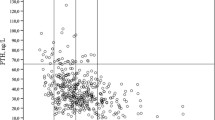Abstract
This study aimed to investigate the relationship between 25-hydroxyvitamin D [25(OH)D)] and parathyroid hormone (PTH) levels in adolescent females residing in a northern climate. Concern regarding vitamin D status in this population is due to limited sunlight exposure in northern latitudes, decreased outdoor recreational activities, as well as decreased conversion in black girls from increased skin pigmentation. In this cross-sectional analysis, serum samples were assayed for 25(OH)D using competitive protein binding (CPB) assay and PTH with immuno-radiometric (RIA) procedures. Four hundred postmenarcheal females (12–18 years) residing in northeastern Ohio were recruited. Subjects were excluded if they had a history of bone, kidney, or liver disease, or used medications that affect bone. The primary goal was to determine serum 25(OH)D concentrations in relation to circulating PTH levels in a population of adolescent girls. The Spearman correlation test was used to compare PTH and 25(OH)D. Fit multiple split models were run to determine change in slope of the regression line when 25(OH)D and PTH were plotted. Analysis of variance was determined using modeled means with differences by race and season in the final model. Unadjusted mean serum 25(OH)D and PTH levels were 55.0±30.4 nmol/l and 39.4±20.6 ng/l, respectively. Blacks had lower 25(OH)D and higher PTH compared with non-blacks (P<0.0001), especially during the winter months. Decreasing 25(OH)D was inversely correlated with PTH (r=−0.314) (P<0.0001), and at concentrations of 25(OH)D ≤90 nmol/l, an increase in PTH was observed. Adolescents are at risk for decreased serum 25(OH)D concentrations, especially black girls. We found that the widely used cutoff for vitamin D deficiency is associated with increasing PTH levels and is below the inflection point for a change in the slope of the regression line. Our results support the need for further research to establish optimal vitamin D status in adolescent girls.



Similar content being viewed by others
References
Calvo MS (2003) Prevalence of vitamin D insufficiency in Canada and the United States: importance to health status and efficacy of current food fortification and dietary supplement use. Nutr Rev 61:107–113
Vieth R (1999) Vitamin D supplementation, 25-hydroxyvitamin D concentrations, and safety. Am J Clin Nutr 69:842–856
Lips P, Wiersinga A, VanGinkel FC, Jongen MJM, Netelenbos JC, Hackeng WHL, Delmas PD, VanDerVijgh WJF (1988) The effects of vitamin D supplementation on vitamin D status and parathyroid hormone function in elderly subjects. J Clin Endocrinol Metab 67:644–650
Institute of Medicine, Standing Committee on the Scientific Evaluation of Dietary Reference Intakes (1997) Vitamin D. In: Dietary reference intakes for calcium, phosphorus, magnesium, vitamin D, and fluoride. National Academy Press, Washington D.C., pp 250–287
Tangpricha V, Pearce EN, Chen TC, Holick MF (2002) Vitamin D insufficiency among free-living healthy young adults. Am J Med 112:659–662
Guillemant J, Taupin P, Le HT, Taright N, Allemandou A, Pérès G, Guillemant S (1999) Vitamin D status during puberty in French healthy male adolescents. Osteoporos Int 10:222–225
Docio S, Riancho JA, Pérez A, Olmos JM, Amado JA, González-Macías J (1998) Seasonal deficiency of vitamin D in children: potential target for osteoporosis-preventing strategies? J Bone Miner Res 13:544–548
Guillemant J, Le H-T, Maria A, Allemandou A, Pérès G, Guillemant S (2001) Wintertime vitamin D deficiency in male adolescents: effect on parathyroid function and response to vitamin D supplements. Osteoporos Int 12:875–879
Outila TA, Kärkkäinen MUM, Lamberg-Allardt CJE (2001) Vitamin D status affects serum parathyroid hormone concentrations during winter in female adolescents: associations with forearm bone mineral density. Am J Clin Nutr 74:206–210
Barger-Lux MJ, Heaney RP, Dowell S, Chen TC, Holick MF (1998) Vitamin D and its major metabolites: serum levels after graded oral dosing in healthy men. Osteoporosis Int 8:222–830
Heaney RP (1999) Lessons for nutritional science from vitamin D. Am J Clin Nutr 69:825–826
Malabanan A, Veronikis IE, Holick MF (1998) Redefining vitamin D insufficiency. Lancet 351:805–806
Lips P, Chapuy MC, Dawson-Hughes B, Pols HAP, Holick MF (1999) An international comparison of serum 25-hydroxyvitamin D measurements. Osteoporos Int 9:394–397
Chapuy MC, Preziosi P, Maamer M, Arnaud S, Galan P, Hercberg S, Meunier PJ (1997) Prevalence of vitamin D insufficiency in an adult normal population. Osteoporos Int 7:439–443
Oliveri MB, Ladizesky M, Mautalen CA, Alonso A, Martinez L (1993) Seasonal variations of 25 hydroxyvitamin D and parathyroid hormone in Ushuaia (Argentina), the southernmost city in the world. Bone Miner 20:99–108
Bell NH, Greene A, Epstein S, Oexmann MJ, Shaw S, Shary J (1985) Evidence for alteration of the vitamin D-endocrine system in blacks. J Clin Invest 76:470–473
Parisien M, Cosman F, Morgan D, Schnitzer M, Liang X, Nieves J, Forese L, Luckey M, Meier D, Shen V, Lindsay R, Dempster DW (1997) Histomorphometric assessment of bone mass, structure, and remodeling: a comparison between healthy black and white premenopausal women. J Bone Miner Res 12:948–956
Scharla SH (1998) Prevalence of subclinical vitamin D deficiency in different European countries. Osteoporos Int 8:S7-S12
Peacock M (1998) Effects of calcium and vitamin D insufficiency on the skeleton. Osteoporos Int 8:S45-S51
Zitterman A (2003) Vitamin D in preventive medicine: are we ignoring the evidence? Br J Nutr 89:552–572
Moncrieff MW, Lunt HR, Arthur LJ (1973) Nutritional rickets at puberty. Arch Dis Child 48:221–224
Narchi H, El Jamil M, Kulaylat N (2001) Symptomatic rickets in adolescents. Arch Dis Child 84:501–503
Acknowledgements
The research presented in this manuscript was supported by NIH grant #M01 RR00080 (National Center for Research Resources) and NIH grant #HD390099 (Contraceptive and Reproductive Health Branch, Center for Population Research, NICHD). We would like to acknowledge the statistical analysis assistance of Michelle Secic.
Author information
Authors and Affiliations
Corresponding author
Rights and permissions
About this article
Cite this article
Harkness, L., Cromer, B. Low levels of 25-hydroxy vitamin D are associated with elevated parathyroid hormone in healthy adolescent females. Osteoporos Int 16, 109–113 (2005). https://doi.org/10.1007/s00198-004-1656-8
Received:
Accepted:
Published:
Issue Date:
DOI: https://doi.org/10.1007/s00198-004-1656-8




